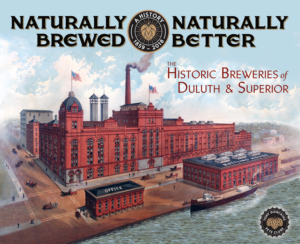Historic Minnesota Iron Range Breweries

The Virginia Brewing Company ca. 1915. (Image: Zenith City Press)
After Michael Fink sold his brewery in 1885, he remained “retired” until becoming a health inspector in 1888. in October 1891, newspapers announced he had purchased five acres of land on the intending to build a brewery. Investors included his wife, Callie, and majority stockholder Philip M. Graff, a lumber baron. Charlie “Spike” Unden, nephew of pioneer Duluth brewer Nick Decker Sr., joined Fink in Tower, Minnesota, to make beer. Brewing historian Doug Hoverson reports that Fink’s operation found itself on unstable financial footing almost from the start, and a er just two years, “sold the brewery to a group of investors from Duluth.” Fink returned to Duluth and set up a farm on Maple Grove Road. He died in 1899 of tuberculosis, the same disease that killed Decker. Fink’s obituary mentioned that he had “scores of old friends, and many expressions of regret were heard yesterday when the news of his death had spread.” Unden began working as a brewer for A. Fitger & Co. in 1895 and remained there until retiring in 1937.
The investors reorganized the operation as the iron Range Brewing Co. A few years later ownership changed hands again. The Duluth News Tribune reported in 1897 that Samuel Owens, George Hunter, and William H. McQuade—all Tower residents—purchased the brewery and reorganized it as the iron Range Brewing Association. Its first bottled beer was a pilsner. While the brewery bo led and shipped beer throughout the iron Range, it remained small—in 1904 the operation employed just four men. Reports indicate the brewery could produce about three thousand barrels a year. The brewery later labeled its beer under the name Prima. Reports indicate that when Prohibition became law, the brewery briefly made a cereal beverage called Iron Beer before closing its doors.
In April 1904, Duluth and iron range newspapers announced that investors had organized a “co-op brewery” for the Mesabi iron Range. The new brewery hoped to attract the business of half the saloons on the Range, despite fear of opposition from the “large brewing companies whose sales on the range are now enormous.” Organizer Albert Olson previously worked on the Range as a sales agent for Duluth’s A. Fitger & Co. The group chose to locate the brewery in Virginia in 1905. Hardware-store owner and three- time Ely mayor Patrick “Paddy” R. Vail, along with A. D. Ellefson, Nels Anderson, and saloon owner Alex Pakkala, incorporated the Virginia Brewing Company and announced the construction of a brewery on the bank of Silver Lake. Later that year the News Tribune briefly mentioned that “Virginia is going to have a new brewery and will have an opportunity to drown its sorrows in home made beer.”
Hoverson reports that Chicago brewery architect Bernard Barthel designed the facility, expected to cost $150,000 including both buildings and equipment. it would have the capacity to produce 25,000 barrels of beer per year, and the new company tapped August Teisse to serve as its first brewmaster.
When Virginia Brewing delivered its first beer Christmas week 1906, it had already opened nine accounts in Virginia and six more in Eveleth. The brewery aggressively pursued sales, as Hoverson notes, building depots in six Iron Range cities within a year after opening and later adding a fifty-thousand-barrel storage facility. Researcher Jay Bago reports the brewery produced Old Bavarian, Old Virginian, Pride of the Range, and a “Berliner style” beer named Mesaba Range Lager Bier. in Virginia, beer drinkers called the lager “Virginia Budweiser” not for its taste but because its label looked nearly identical to that of Anheuser-Busch’s flagship brand. The label came in two versions, one in English and the other in German. in 1908 Anheuser-Busch sued the Virginia Brewing Co. for $5,000 and demanded it stop using the design. For reasons unrecorded, Anheuser-Busch dropped the lawsuit. The issue was likely settled out of court.
in January 1912 a drunken customer shot Pakkala dead in his own saloon. Just over a year later Paddy vail, who had gone on to serve as a state representative and senator, also died. Newspapers reported he had recently visited several health resorts seeking relief from “general derangement” and smallpox had hastened his demise.
The next few years found the brewery embroiled in various lawsuits, most involving liquor licenses and missing money. Several reports indicate that Virginia Brewing Co. closed its doors in 1918 when St. Louis County elected to go dry. However, a label for its Gold Crown Temperance Beer declared the beverage “less than 1/2 of 1%,” which meant it was made after January 1920 and the company had briefly attempted to survive Prohibition.
Neither the iron Range Brewing Association nor the Virginia Brewing Company reopened a er the repeal of Prohibition. The Virginia Brewing Company brewery, currently unoccupied, is listed on the National Register of Historic Places. Most of the iron Range Brewery is gone, but its ice house—the home of Margie’s Iron Range Bar from 1955 to 2011—still stands.
 From Naturally Brewed, Naturally Better: The Historic Breweries of Duluth & Superior by Tony Dierckins & Pete Clure (Zenith City Press, 2018) featuring over 600 historic photographs and lithographs, including nearly every label that ever graced a bottle of a historic Twin Ports beer. Click on the cover to preview the book.
From Naturally Brewed, Naturally Better: The Historic Breweries of Duluth & Superior by Tony Dierckins & Pete Clure (Zenith City Press, 2018) featuring over 600 historic photographs and lithographs, including nearly every label that ever graced a bottle of a historic Twin Ports beer. Click on the cover to preview the book.









